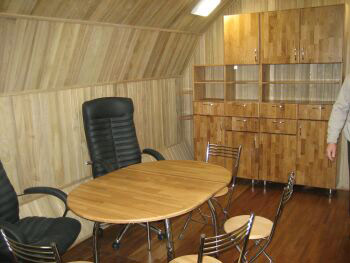Europe to Join 500-Day Mock Mission to Mars

TheEuropean Space Agency (ESA) will partner with Russian researchers to lock acrew of six people in metal tubes for a simulated trip to Mars.
Known asMars500, thesimulated space mission will take place in an isolation facility in Russia,allowing organizers to study the difficulties presented by such a lengthyspaceflight. The participants, selected from a pool of volunteers, will attemptto re-create all elements of an actual mission, including launch, an outboardjourney, a research trip to the planet's surface, and the return trip--all ofwhich will take 500 days.
Lockedinside the research station, the crew will have to deal with limitations suchas a carefully portioned food supply, 20-minute delays in communication, andsimulated emergencies, with the further possibility of real medical emergenciesarising.
The study,organized by the Russian Institute for Biomedical Problems (IBMP), will nowinclude experiments being sought out by the ESA for the participants to carryout during their extended period of sequestration. The ESA will be a full partner inthe project, with major funding from Russia'sFederal Space Agency, and significant involvement by the Russian Academyof Sciences.
Thespaceship mock-up will include areas for research, medicine, living, and akitchen, having a total area of 200 square meters, connected only by narrowpassages. Further, a special tank will be provided to represent a descentvehicle for travel to the Martian surface.
The sixparticipants, who will be away from home and family for over one-and-a-halfyears, will be drawn from volunteers in the general populace. They areexpected to possess medical, engineering, and scientific qualifications,although physical characteristics might be less emphasized for this project.
Marc Heppener, ESA scientist, describes the ESA'sinterest in joining the experiment in an ESA interview: "Our main interestis to look at the psychology of such a mission, knowing that you are enclosedfor 500 days. As soon as there is a problem, the crew knows that they are ontheir own, and they have to solve it themselves. The only help available fromthe outside is through communications which may take up to 40 minutes...Therewill be one person amongst the crew with real medical training. But of coursethat person can also fall ill. So you have to have all kinds of back-upscenarios."
Breaking space news, the latest updates on rocket launches, skywatching events and more!
Thepotential for scientific research during the mock mission are numerous,according to Heppener: "We have a first draft list of the kind of science weare looking for...the influence of confinement on sleep, mood and mental health,and the effect of differences in personality, cultural background andmotivation. But also on the medical side - physiological adaptation to anisolated environment, stress effects on health and well-being, changes in theimmune system." The ESA will simultaneously consider proposals for similarresearch at the Concordia Antarctic research station, which offers acontrasting stark environment.
When asked if Mars500 might be compared to a reality TVshow, Heppener replied, "[They] both look atinteraction between people in all kinds of different situations. If you wantthere is even a prize at the end - not in the simulation - but if it is a realmission you will be the first person to walk on the surface of Mars, which ishuge prize! Thecomparison comes to a very sharp dead-end though - we will do a serious scienceexperiment."
- Mars Madness: A Multimedia Adventure!
- IMAGES: A Mars Base of the Future
- All About Mars

